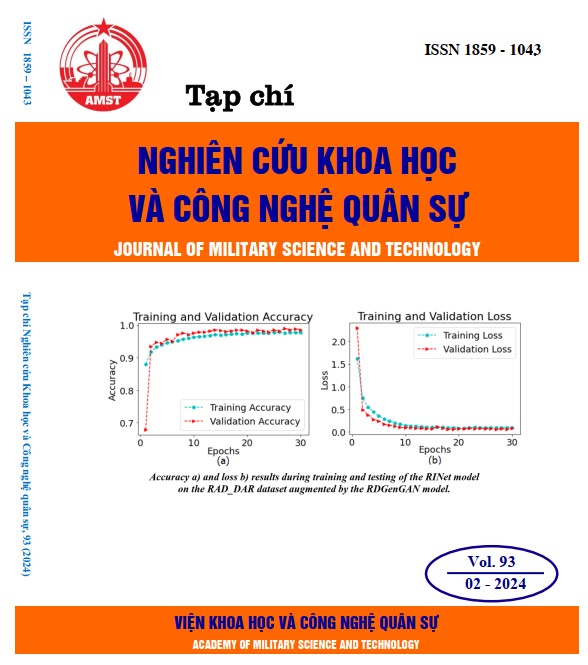Adaptive control technique to enhance differential multi-objective evolutionary algorithm based on variation rate of quality measures
343 viewsDOI:
https://doi.org/10.54939/1859-1043.j.mst.93.2024.121-127Keywords:
Balancing exploration and exploitation; Search trend; Differential evolutionary algorithm; NSGAII-DE.Abstract
When evaluating the multi-objective evolutionary algorithm, they not only focus on the quality of the solution set but also pay attention to the algorithm's ability to explore and exploit because that is the factor ensuring the convergence and diversity of the solution set. Maintaining a balance between exploration and exploitation of the algorithm is a difficult but interesting problem in the research field. In this article, we analyzed the relationship between the quality of the solution set and the algorithm's search efficiency to evaluate trends and propose an adaptive control technique based on the variation rate of quality measures to maintain a better balance between the exploration and exploitation capabilities. Experimental results on the multi-objective evolutionary algorithm using differential direction with some typical benchmark sets are highly competitive, demonstrating the ability to improve the algorithm's efficiency.
References
[1]. Nguyễn Long, “Kỹ thuật định hướng trong tối ưu tiến hóa đa mục tiêu”, NXB Đại học Kinh tế quốc dân, Hà Nội, (2020).
[2]. H. Wenlan, Zh.Yu, and L. Lan, “Survey on multi-objective evolutionary algorithms”, J. of Physics: Conference Series, Vol 1288:012057 (2019). DOI: https://doi.org/10.1088/1742-6596/1288/1/012057
[3]. D.A.V. Veldhuizen, “Multi-objective evolutionary algorithms: Classifications, analyses, and new innovation”, PhD thesis, Airforce Institue of Technology, Ohio (1999).
[4]. C. A. C. Coello, N.C. Cortés, “Solving Multiobjective Optimization Problems using an Artificial Immune System”, J. of Genet Program Evolvable, Vol. 6, No.2, pp.163-190, (2005). DOI: https://doi.org/10.1007/s10710-005-6164-x
[5]. E. Zitzler, L. Thiele, and K. Deb, “Comparision of multiobjective evolutionary algorithms: Emprical results”, J. of Evolutionary Computation, Vol 8, No.1, pp. 173-195, (2000). DOI: https://doi.org/10.1162/106365600568202
[6]. H. Zhang, J. Sun, T. Liu, K. Zhang, Q. Zhang, “Balancing Exploration and Exploitation in Multiobjective Evolutionary Optimization”, J. of Information Sciences, Vol 497, pp. 129-148, (2019). DOI: https://doi.org/10.1016/j.ins.2019.05.046
[7]. W. Zheng, J. Wu, C. Zhang, J. Sun, “A Clustering-Based Multiobjective Evolutionary Algorithm for Balancing Exploration and Exploitation”, Proc. of 14th Bio-inspired Computing: Theories and Applications, Vol. 1, No.14, pp. 355-369, (2020). DOI: https://doi.org/10.1007/978-981-15-3425-6_28
[8]. M. Abdel-Basset, R. Mohamed, S. Mirjalili, R. K. Chakrabortty, M. J. Ryan, “MOEO-EED: A multi-objective equilibrium optimizer with exploration–exploitation dominance strategy”, J. of Knowledge-Based Systems, Vol, No. 214, 106717, (2021). DOI: https://doi.org/10.1016/j.knosys.2020.106717
[9]. Q. Zhang, R. Jiao, S. Zeng, Z. Zeng, “Balancing Exploration and Exploitation With Decomposition-Based Dynamic Multi-Objective Evolutionary Algorithm”, J. of International Journal of Cognitive Informatics and Natural Intelligence (IJCINI), Vol. 15, No. 4, pp.1-23, (2021). DOI: https://doi.org/10.4018/IJCINI.20211001.oa25
[10]. H. Hong, M. Jiang, L. Feng, Q. Lin, K.C. Tan, “Balancing Exploration and Exploitation for Solving Large-scale Multiobjective Optimization via Attention Mechanism”, Proc. of 2022 IEEE Congress on Evolutionary Computation, pp.1-8, (2022). DOI: https://doi.org/10.1109/CEC55065.2022.9870430
[11]. C. Kwan, F. Yang and C. Chang, “A differential evolution variant of Nsga ii for real world multiobjective optimization”, Proc. of Artificial Life: Third Australian Conference; ACAL 2007 Gold Coast, Australia, pp. 345-356, (2007). DOI: https://doi.org/10.1007/978-3-540-76931-6_30
[12]. Q. Zhang, A. Zhou, S. Zhao, P. N. Suganthan, W. Liu, and S. Tiwari, “Multiobjective optimization test instances for the CEC 2009 specialsession and competition”, University of Essex and NanyangTechnological University, Tech. Rep. CES-487, (2008).







